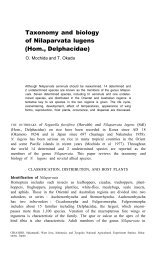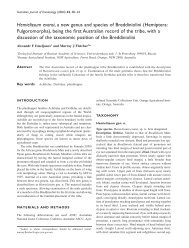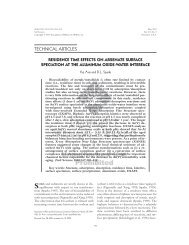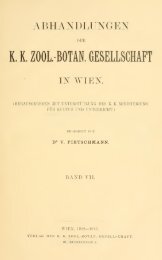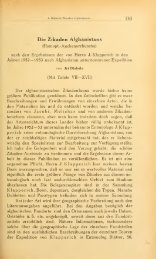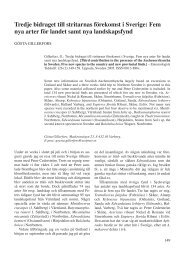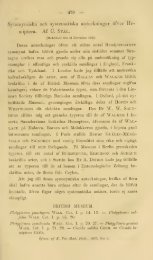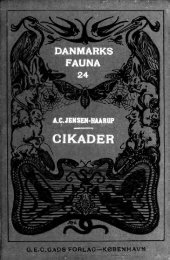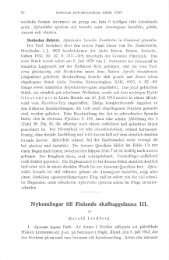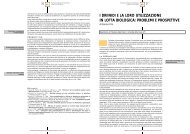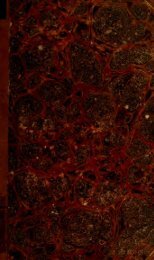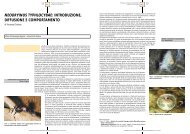Intraspecific Variation in Chemical Attraction of Rice to Insect ...
Intraspecific Variation in Chemical Attraction of Rice to Insect ...
Intraspecific Variation in Chemical Attraction of Rice to Insect ...
Create successful ePaper yourself
Turn your PDF publications into a flip-book with our unique Google optimized e-Paper software.
BIOLOGICAL CONTROL 6, 394–400 (1996)<br />
ARTICLE NO. 0050<br />
<strong>Intraspecific</strong> <strong>Variation</strong> <strong>in</strong> <strong>Chemical</strong> <strong>Attraction</strong> <strong>of</strong> <strong>Rice</strong> <strong>to</strong> <strong>Insect</strong> Preda<strong>to</strong>rs<br />
HERMINIA R. RAPUSAS,* DALE G. BOTTRELL,† AND MOSHE COLL‡<br />
*Division <strong>of</strong> En<strong>to</strong>mology and Plant Pathology, International <strong>Rice</strong> Research Institute, P.O. Box 933, 1099 Manila, Philipp<strong>in</strong>es;<br />
†Department <strong>of</strong> En<strong>to</strong>mology, University <strong>of</strong> Maryland, College Park, Maryland 20742; and ‡Department <strong>of</strong> En<strong>to</strong>mology,<br />
The Hebrew University <strong>of</strong> Jerusalem, P.O.B. 12, Rehovat, 76100 Israel<br />
The olfac<strong>to</strong>ry response <strong>of</strong> preda<strong>to</strong>rs <strong>of</strong> the brown<br />
planthopper, Nilaparvata lugens Stål, <strong>to</strong> different genotypes<br />
<strong>of</strong> rice (14 cultivars and breed<strong>in</strong>g l<strong>in</strong>es <strong>of</strong> Oryza<br />
sativa L. and 1 wild species, Oryza nivara Sharma et<br />
Shastry) was measured <strong>in</strong> an airflow olfac<strong>to</strong>meter.<br />
Odor from rice plants attracted more females <strong>of</strong> the<br />
mirid preda<strong>to</strong>r Cyr<strong>to</strong>rh<strong>in</strong>us lividipennis Reuter than<br />
pla<strong>in</strong> air (control) on only 6 <strong>of</strong> the 15 rice genotypes.<br />
Orientation <strong>of</strong> C. lividipennis <strong>to</strong>ward volatiles <strong>of</strong> certa<strong>in</strong><br />
rice genotypes was apparent even when the plants<br />
were free <strong>of</strong> the brown planthopper. However, the<br />
preda<strong>to</strong>r dist<strong>in</strong>guished between prey-<strong>in</strong>fested and un<strong>in</strong>fested<br />
plants and preferred plants with eggs over<br />
plants with nymphs. The preda<strong>to</strong>r did not dist<strong>in</strong>guish<br />
different stages <strong>of</strong> plant growth (vegetative, boot<strong>in</strong>g,<br />
or flower<strong>in</strong>g). Plants artificially <strong>in</strong>jured <strong>to</strong> simulate<br />
brown planthopper oviposition wounds were not as<br />
attractive <strong>to</strong> the preda<strong>to</strong>r as plants on which the<br />
planthopper had oviposited. The preassay precondition<strong>in</strong>g<br />
on the cultivar TN1 did not produce a preda<strong>to</strong>r<br />
bias for this genotype. This suggests that rear<strong>in</strong>g<br />
effects or chemically mediated associative learn<strong>in</strong>g<br />
reported for some natural enemies did not <strong>in</strong>fluence C.<br />
lividipennis’host response. Results with another preda<strong>to</strong>r,<br />
the cocc<strong>in</strong>ellid Micraspis hirashimai Sasaji, produced<br />
less consistent behavior. Planthopper-<strong>in</strong>fested<br />
plants attracted more females <strong>of</strong> M. hirashimai than<br />
unifested plants <strong>in</strong> only 1 <strong>of</strong> the 12 rice genotypes<br />
evaluated. Implications for augment<strong>in</strong>g preda<strong>to</strong>rs by<br />
rice cultivar selection and modification are dis-<br />
cussed. r 1996 Academic Press, Inc.<br />
KEY WORDS: Cyr<strong>to</strong>rh<strong>in</strong>us lividipennis; Micraspis hirashimai;<br />
Nilaparvata lugens; rice; plant volatiles.<br />
INTRODUCTION<br />
The olfac<strong>to</strong>ry system <strong>of</strong> natural enemies must accomplish<br />
several tasks (Vet and Dicke, 1992). Responses <strong>to</strong><br />
volatile phy<strong>to</strong>chemicals may be especially important <strong>in</strong><br />
guid<strong>in</strong>g enemies <strong>to</strong> their host or prey habitats (Price et<br />
al., 1980; Turl<strong>in</strong>gs et al., 1991). Some natural enemies<br />
even dist<strong>in</strong>guish volatiles from closely related plant<br />
1049-9644/96 $18.00<br />
Copyright r 1996 by Academic Press, Inc.<br />
All rights <strong>of</strong> reproduction <strong>in</strong> any form reserved.<br />
Received May 8, 1995; accepted December 19, 1995<br />
394<br />
cultivars (Elzen et al., 1985, 1986). Volatile phy<strong>to</strong>chemicals<br />
contribute little <strong>to</strong> a plant’s <strong>to</strong>tal mass and their<br />
concentration is dilute (Buttery and L<strong>in</strong>g, 1985), yet<br />
plants produce a wide range <strong>of</strong> volatiles (Hernandez et<br />
al., 1989; Connick et al., 1989).<br />
The efficiency <strong>of</strong> some preda<strong>to</strong>rs attack<strong>in</strong>g the brown<br />
planthopper, Nilaparvata lugens Stål, on rice, Oryza<br />
sativa L., varies with rice cultivar. Kar<strong>to</strong>hardjono and<br />
He<strong>in</strong>richs (1984) found that predation by lycosid spiders<br />
was higher on resistant cultivars than on susceptible<br />
cultivars. Sogawa (1982) showed that the brown<br />
planthopper probes more and is more active on resistant<br />
plants than on susceptible plants. Therefore, the<br />
herbivore is apparently easier for the visually responsive<br />
spiders <strong>to</strong> detect on resistant plants. Senguttuvan<br />
and Gopalan (1990) reported that the mirid preda<strong>to</strong>r<br />
Cyr<strong>to</strong>rh<strong>in</strong>us lividipennis Reuter is more effective<br />
aga<strong>in</strong>st the brown planthopper on resistant rice cultivars<br />
than on susceptible rice cultivars, which they<br />
attributed <strong>to</strong> greater planthopper activity on resistant<br />
plants.<br />
The role <strong>of</strong> volatile phy<strong>to</strong>chemicals <strong>in</strong> mediat<strong>in</strong>g<br />
natural enemy behavior or the tritrophic <strong>in</strong>teractions<br />
<strong>in</strong> rice is not known. <strong>Rice</strong> produces many foliage<br />
volatiles, the chemical composition <strong>of</strong> which may differ<br />
among rice genotypes (Hernandez et al., 1989). Worldwide,<br />
there are 100,000 <strong>to</strong> 120,000 dist<strong>in</strong>ct cultivated<br />
rice genotypes (Chang, 1989; IRRI, 1980) and many<br />
different cultivars may be grow<strong>in</strong>g simultaneously <strong>in</strong><br />
an area. Variable production <strong>of</strong> volatiles across cultivars<br />
may affect the composition and efficiency <strong>of</strong> preda<strong>to</strong>rs<br />
<strong>in</strong> rice.<br />
The objectives <strong>of</strong> this research were <strong>to</strong> (1) measure<br />
the olfac<strong>to</strong>ry response <strong>of</strong> two <strong>in</strong>sect preda<strong>to</strong>rs (C.<br />
lividipennis and the cocc<strong>in</strong>ellid Micraspis hirashimai<br />
Sasaji) <strong>of</strong> the brown planthopper <strong>to</strong> different rice<br />
genotypes, (2) determ<strong>in</strong>e variation <strong>in</strong> olfac<strong>to</strong>ry response<br />
among different growth stages <strong>of</strong> rice, and (3)<br />
compare preda<strong>to</strong>r response <strong>to</strong> different rice genotypes<br />
with and without brown planthopper prey. C. lividipennis<br />
occurs <strong>in</strong> rice <strong>in</strong> Asia and the Pacific islands (Chiu,<br />
1979; Döbel and Denno, 1994). This mirid preys on eggs
and nymphs <strong>of</strong> the brown planthopper, rice whitebacked<br />
planthopper, Sogatella furcifera Horváth, and<br />
rice green leafhopper, Nephotettix virescens Distant. M.<br />
hirashimai feeds on nymphs and adults <strong>of</strong> leafhoppers<br />
and planthoppers and may consume many other species.<br />
MATERIALS AND METHODS<br />
Olfac<strong>to</strong>meter Setup<br />
Preda<strong>to</strong>r response <strong>to</strong> rice plants was measured <strong>in</strong> a<br />
modified four-armed airflow olfac<strong>to</strong>meter <strong>of</strong> Vet et al.<br />
(1983) <strong>to</strong> allow assays with whole rice plants (Fig. 1).<br />
Instead <strong>of</strong> us<strong>in</strong>g the 50-ml odor source glass vials <strong>of</strong> the<br />
orig<strong>in</strong>al olfac<strong>to</strong>meter, we used cyl<strong>in</strong>drical plant cham-<br />
PREDATOR RESPONSE TO RICE<br />
bers (100 cm tall, 16 cm <strong>in</strong>side diameter) <strong>of</strong> 16-guage<br />
galvanized iron. The cyl<strong>in</strong>der’s bot<strong>to</strong>m was sealed by<br />
weld<strong>in</strong>g a galvanized iron disk <strong>to</strong> it. Its <strong>to</strong>p had a<br />
2-cm-wide rim circl<strong>in</strong>g the cyl<strong>in</strong>der’s mouth fitted with<br />
six screw holes <strong>to</strong> receive a removable galvanized iron<br />
cover (20.5 cm diameter). A 4-mm cork gasket between<br />
the rim and the cover prevented air leaks. The chamber’s<br />
cover was fitted with one copper tube <strong>to</strong> receive air<br />
from an air compressor and another <strong>to</strong> direct exit<strong>in</strong>g air<br />
<strong>in</strong><strong>to</strong> an exposure chamber where preda<strong>to</strong>rs were released.<br />
Four odor fields were created <strong>in</strong>side the plexiglass<br />
exposure chamber by flow<strong>in</strong>g air from the compressor.<br />
Each odor field had a tube lead<strong>in</strong>g <strong>to</strong> a 500-ml Erlenmeyer<br />
flask <strong>to</strong> trap <strong>in</strong>sects reach<strong>in</strong>g the tube. The trap<br />
FIG. 1. Four-armed airflow olfac<strong>to</strong>meter <strong>of</strong> Vet et al. (1983) modified <strong>to</strong> allow whole rice plant analysis.<br />
395
396 RAPUSAS, BOTTRELL, AND COLL<br />
flask was connected <strong>to</strong> the plant chamber, which was<br />
connected <strong>to</strong> another 500-ml Erlenmeyer flask conta<strong>in</strong><strong>in</strong>g<br />
distilled water. The water created a high, uniform<br />
humidity <strong>in</strong> the <strong>in</strong>com<strong>in</strong>g air pass<strong>in</strong>g over it. All<br />
connections were made <strong>of</strong> silicon rubber tub<strong>in</strong>g. Airflow<br />
was equalized <strong>in</strong> the four odor fields by regulat<strong>in</strong>g air<br />
that passed through each arm <strong>to</strong> a rate <strong>of</strong> 5 ml/s with a<br />
Gilmont flowmeter. The air exited through a center hole<br />
<strong>in</strong> the bot<strong>to</strong>m <strong>of</strong> the exposure chamber. Illum<strong>in</strong>ation<br />
was by two 10-W tube fluorescent lamps suspended<br />
from a wooden frame 30 cm above the exposure chamber.<br />
The light<strong>in</strong>g system and exposure chamber were<br />
covered with a black cloth <strong>to</strong> prevent disturbance <strong>of</strong> the<br />
released <strong>in</strong>sects. Observations were made through a<br />
peephole <strong>in</strong> the cloth above the center <strong>of</strong> the exposure<br />
chamber.<br />
A series <strong>of</strong> ‘‘smoke’’ tests (Vet et al., 1983) showed that<br />
the olfac<strong>to</strong>meter produced dist<strong>in</strong>ct odor fields with no<br />
turbulence or mix<strong>in</strong>g <strong>of</strong> adjacent fields <strong>in</strong> the exposure<br />
chamber when the airflow was 5 ml/s. Prelim<strong>in</strong>ary<br />
trials at this sett<strong>in</strong>g showed that both species <strong>of</strong><br />
preda<strong>to</strong>rs discrim<strong>in</strong>ated food from nonfood sources <strong>in</strong><br />
the odor fields.<br />
All assays were conducted between 07:00 and 18:00 hr<br />
<strong>in</strong> a room ma<strong>in</strong>ta<strong>in</strong>ed at 25° 6 3°C and 68 6 5% relative<br />
humidity.<br />
Plant Genotypes Evaluated<br />
<strong>Rice</strong> genotypes evaluated <strong>in</strong>cluded five cultivars<br />
developed by the International <strong>Rice</strong> Research Institute<br />
(IRRI), IR28, IR64, IR68, IR72, and IR74; IRRI<br />
breed<strong>in</strong>g l<strong>in</strong>es, IR33059-26-2-2, IR49491-192-1-1-2,<br />
IR50404-57-2-2-3, IR56382-123-1-3-1, IR56446-94-3-<br />
1-2, IR56455-91-1-3-2, and IR57283-77-2-2-3; traditional<br />
cultivars, Peta and TN1; and the wild species,<br />
Oryza nivara Sharma et Shastry. These genotypes<br />
represent wide differences <strong>in</strong> genetic background and<br />
<strong>in</strong>clude both brown planthopper-susceptible (Peta and<br />
TN1) and -resistant genotypes (unpublished). We grew<br />
the rice plants <strong>in</strong> a greenhouse <strong>in</strong> clay pots (one<br />
plant/16.5-cm-diameter 3 16-cm-tall pot) with soil, watered<br />
them daily, and provided ammonium sulfate (20%<br />
N) five times from seedl<strong>in</strong>g <strong>to</strong> maximum tiller<strong>in</strong>g<br />
stages (<strong>to</strong>tal <strong>of</strong> 0.75–1.00 g/pot). Plant<strong>in</strong>gs were staggered<br />
over several weeks <strong>to</strong> assure enough plants <strong>of</strong> the<br />
desired age at assay time.<br />
Preda<strong>to</strong>r Response <strong>to</strong> Different <strong>Rice</strong> Genotypes<br />
The response <strong>of</strong> C. lividipennis <strong>to</strong> the 15 rice genotypes<br />
<strong>in</strong> the vegetative stage <strong>of</strong> growth (45–50 days old)<br />
was compared. For the assays, we used plants free <strong>of</strong><br />
apparent <strong>in</strong>sect or pathogen <strong>in</strong>jury. We uprooted two<br />
potted plants <strong>of</strong> one genotype, washed their roots with<br />
runn<strong>in</strong>g water, removed dried leaves, and stripped all<br />
but five uniform tillers from each plant. We wrapped<br />
the roots <strong>of</strong> one plant <strong>in</strong> cot<strong>to</strong>n, placed the plant <strong>in</strong> a<br />
glass beaker, and put the beaker <strong>in</strong> the olfac<strong>to</strong>meter’s<br />
plant chamber. Water was periodically added <strong>to</strong> the<br />
cot<strong>to</strong>n surround<strong>in</strong>g the plants’ roots <strong>to</strong> prevent dryness.<br />
Two <strong>of</strong> the chamber’s odor fields were assigned <strong>to</strong><br />
plants and two were assigned <strong>to</strong> controls (beakers with<br />
water-saturated cot<strong>to</strong>n). Location <strong>of</strong> odor fields <strong>in</strong> the<br />
exposure chamber (two for the plants and two for the<br />
control) was the same for all randomly selected rice<br />
genotypes.<br />
All assays used 1- <strong>to</strong> 2-day old female preda<strong>to</strong>rs<br />
reared <strong>in</strong> the greenhouse on TN1 rice plants <strong>in</strong>fested<br />
with the brown planthopper that had been starved for<br />
3–4 h before an assay. We flowed air through the<br />
exposure chamber for 10 m<strong>in</strong> before <strong>in</strong>troduc<strong>in</strong>g preda<strong>to</strong>rs<br />
s<strong>in</strong>gly through the chamber’s air exit hole. They<br />
were allowed <strong>to</strong> walk up <strong>in</strong><strong>to</strong> the chamber from a<br />
release tube held vertically under the hole. Preda<strong>to</strong>r<br />
location <strong>in</strong> the chamber was recorded at 1, 2, 5, and 10<br />
m<strong>in</strong> us<strong>in</strong>g the odor field sec<strong>to</strong>r system <strong>of</strong> Vet et al.<br />
(1983). This system divided the exposure chamber <strong>in</strong><strong>to</strong><br />
four equal sec<strong>to</strong>rs, the tip <strong>of</strong> each <strong>of</strong> which radiated 90°<br />
<strong>to</strong>ward an odor field. Therefore, a record<strong>in</strong>g always<br />
assigned a preda<strong>to</strong>r <strong>to</strong> a treatment odor field even if it<br />
had not entered a trap flask or tube between the<br />
exposure chamber and trap flask. We removed and<br />
discarded the preda<strong>to</strong>r after the 10-m<strong>in</strong> observation.<br />
For each rice genotype, we obta<strong>in</strong>ed record<strong>in</strong>gs on the<br />
response <strong>of</strong> 50 <strong>in</strong>dividual C. lividipennis. To prevent<br />
contam<strong>in</strong>ation, we cleaned the olfac<strong>to</strong>meter’s exposure<br />
chamber and trap flasks with 95% ethyl alcohol and<br />
then distilled water and purged it with pla<strong>in</strong> air<br />
between observations on any two <strong>in</strong>dividuals.<br />
Each rice genotype (selected randomly from the<br />
collection <strong>of</strong> treatments) was replicated five times <strong>to</strong><br />
obta<strong>in</strong> records on the response <strong>of</strong> 10 C. lividipennis <strong>to</strong><br />
each <strong>of</strong> five plants.<br />
Effects <strong>of</strong> <strong>Rice</strong> Growth Stage<br />
The attraction <strong>of</strong> rice genotypes <strong>in</strong> vegetative, flower<strong>in</strong>g,<br />
and boot<strong>in</strong>g stages <strong>to</strong> C. lividipennis was compared.<br />
Five <strong>of</strong> the genotypes (IR28, IR68, IR74, IR50404-<br />
57-2-2-3, and IR49491-192-1-1-2) attracted more C.<br />
lividipennis than the blank air control <strong>in</strong> the first<br />
experiment us<strong>in</strong>g vegetative plants. The sixth genotype,<br />
IR72, was no more attractive than the control.<br />
Location <strong>of</strong> odor fields <strong>in</strong> the exposure chamber (three<br />
for the different stages and one for the control) was the<br />
same for all randomly selected rice genotypes. For each<br />
rice genotype, we recorded responses <strong>of</strong> 50 1-day-old<br />
female C. lividipennis us<strong>in</strong>g procedures <strong>of</strong> the first<br />
experiment.<br />
Effects <strong>of</strong> Prey on Preda<strong>to</strong>r <strong>Attraction</strong><br />
The effect <strong>of</strong> the brown planthopper on attraction <strong>of</strong><br />
C. lividipennis and M. hirashimai <strong>to</strong> rice plants was
determ<strong>in</strong>ed. For C. lividipennis, we used four rice<br />
genotypes that were more attractive <strong>to</strong> the preda<strong>to</strong>r <strong>in</strong><br />
the first experiment than the blank air control (IR28,<br />
IR68, IR74, and IR50404-57-2-2-3) and four that were<br />
no more attractive than the control (IR64, IR72,<br />
IR57283-77-2-2-3, and IR56455-91-1-3-2). For M. hirashimai,<br />
we used all genotypes tested aga<strong>in</strong>st C.<br />
lividipennis <strong>in</strong> the first experiment except the two<br />
traditional cultivars (Peta and TN1) and the wild<br />
species, O. nivara.<br />
Assayed plants were <strong>in</strong> the vegetative stage, 45–50<br />
days old. The four odor field treatments for each rice<br />
genotype were: plant only, plant plus 20 fifth <strong>in</strong>star<br />
brown planthopper nymphs, plant plus brown planthopper<br />
eggs, and control. Location <strong>of</strong> odor fields <strong>in</strong> the<br />
exposure chamber was the same for all randomly<br />
selected rice genotypes. Plants receiv<strong>in</strong>g brown planthopper<br />
nymphs were <strong>in</strong>fested 2 days before an assay.<br />
Plants receiv<strong>in</strong>g brown planthopper eggs were <strong>in</strong>fested<br />
with 20 gravid females 2 days before an assay; the<br />
females were removed before the assay. For each rice<br />
genotype, we recorded responses <strong>of</strong> 1-day-old female<br />
adults (50 C. lividipennis and 30 M. hirashimai, tested<br />
<strong>in</strong> separate assays) us<strong>in</strong>g procedures <strong>of</strong> the first experiment.<br />
In the C. lividipennis experiment, each rice<br />
genotype (selected randomly from the collection <strong>of</strong><br />
treatments) was replicated five times <strong>to</strong> obta<strong>in</strong> records<br />
on the response <strong>of</strong> 10 C. lividipennis <strong>to</strong> each <strong>of</strong> five<br />
plants. In the M. hirashimai experiment, each rice<br />
genotype (selected randomly from the collection <strong>of</strong><br />
treatments) was replicated three times <strong>to</strong> obta<strong>in</strong> records<br />
on the response <strong>of</strong> 10 C. lividipennis <strong>to</strong> each <strong>of</strong> five<br />
plants.<br />
Preda<strong>to</strong>r Discrim<strong>in</strong>ation between Natural Oviposition<br />
and Simulated Wounds<br />
Whether C. lividipennis can dist<strong>in</strong>guish volatiles<br />
from brown planthopper oviposition wounds and volatiles<br />
from simulated wounds was determ<strong>in</strong>ed for the<br />
rice genotypes IR28, IR64, IR68, and IR72. In the first<br />
experiment, IR28 and IR68 were more attractive <strong>to</strong> the<br />
preda<strong>to</strong>r than the blank air control but IR64 and IR72<br />
were no more attractive than the control. The plants<br />
were <strong>in</strong> the vegetative stage, 45–50 days old. Plants<br />
receiv<strong>in</strong>g brown planthopper eggs were <strong>in</strong>fested with<br />
20 gravid females/plant 1 day before an assay; females<br />
were removed before the assay. Artificial wounds were<br />
made by prick<strong>in</strong>g the stems (50 pricks/stem) with a<br />
sterile needle just before an assay <strong>to</strong> simulate the<br />
planthopper oviposition wounds. Location <strong>of</strong> odor fields<br />
<strong>in</strong> the exposure chamber was the same for all randomly<br />
selected rice genotypes. For each rice genotype, we<br />
recorded responses <strong>of</strong> 90 <strong>in</strong>dividual C. lividipennis<br />
us<strong>in</strong>g procedures <strong>of</strong> the first experiment. Each rice<br />
genotype (selected randomly from the collection <strong>of</strong><br />
treatments) was replicated three times <strong>to</strong> obta<strong>in</strong> re-<br />
PREDATOR RESPONSE TO RICE<br />
cords on the response <strong>of</strong> 30 C. lividipennis <strong>to</strong> each <strong>of</strong><br />
three plants.<br />
Data Analysis<br />
For each rice genotype, we conducted the G test <strong>of</strong><br />
goodness <strong>of</strong> fit <strong>to</strong> compare preda<strong>to</strong>r responses <strong>to</strong> different<br />
odor fields. Responses over time (1 <strong>to</strong> 10 m<strong>in</strong>) were<br />
averaged for the analyses s<strong>in</strong>ce there was no consistent<br />
pattern <strong>in</strong> response at the different observation <strong>in</strong>tervals.<br />
G values were adjusted by William’s correction <strong>to</strong><br />
correct for the small sample size (Sokal and Rohlf,<br />
1995).<br />
RESULTS<br />
Preda<strong>to</strong>r Response <strong>to</strong> Different <strong>Rice</strong> Genotypes<br />
Odor fields with rice plants attracted a greater<br />
number <strong>of</strong> C. lividipennis than the blank odor fields<br />
(Table 1). However, preda<strong>to</strong>r responses deviated significantly<br />
(P # 0.05) from the expected response on only<br />
six genotypes (IR28, IR68, IR49491-192-1-1-2, IR33059-<br />
26-2-2, IR50404-57-2-2-3, and IR74). Volatiles from<br />
these six genotypes attracted more preda<strong>to</strong>rs than the<br />
blank air. TN1, which produced the C. lividipennis used<br />
<strong>in</strong> all experiments, was no more attractive than pla<strong>in</strong><br />
air.<br />
Effects <strong>of</strong> <strong>Rice</strong> Growth Stage<br />
C. lividipennis did not differentiate volatiles from<br />
rice <strong>of</strong> the different growth stages (Table 2). Preda<strong>to</strong>r<br />
TABLE 1<br />
Response <strong>of</strong> C. lividipennis Females <strong>to</strong> Volatiles <strong>of</strong> <strong>Rice</strong><br />
Genotypes <strong>in</strong> the Vegetative Stage <strong>of</strong> Growth<br />
<strong>Rice</strong> genotype<br />
x No. respond<strong>in</strong>g <strong>to</strong><br />
Plant volatiles Control (pla<strong>in</strong> air)<br />
397<br />
Gadj a<br />
IR28 34.50 15.50 7.33***<br />
IR68 34.50 15.50 7.33***<br />
IR49491-192-1-1-2 33.75 16.25 6.20**<br />
IR33059-26-2-2 32.75 17.25 4.83*<br />
IR50404-57-2-2-3 32.75 17.25 4.83*<br />
IR74 32.00 18.00 3.93*<br />
TN1 30.00 20.00 1.99<br />
IR56455-91-1-3-2 30.00 20.00 1.99<br />
IR64 29.75 20.25 1.80<br />
O. nivara 29.50 20.50 1.61<br />
Peta 28.50 21.50 .96<br />
IR56446-94-3-1-2 27.75 22.25 .59<br />
IR57283-77-2-2-3 26.75 23.25 .24<br />
IR56382-123-1-3-1 26.00 24.00 .08<br />
IR72 25.25 24.75 ,.01<br />
a *Significant at P 5 0.05; **significant at P 5 0.025; ***significant<br />
at P 5 0.01 by Williams’ correction (a 5 2; n 5 50) (Sokal and Rohlf,<br />
1995).
398 RAPUSAS, BOTTRELL, AND COLL<br />
TABLE 2<br />
Response <strong>of</strong> C. lividipennis Females <strong>to</strong> Volatiles <strong>of</strong> <strong>Rice</strong><br />
Genotypes <strong>in</strong> Different Stages <strong>of</strong> Growth<br />
<strong>Rice</strong> genotype<br />
Vegetative<br />
plants<br />
x No. respond<strong>in</strong>g <strong>to</strong><br />
Boot<strong>in</strong>g<br />
plants<br />
Flower<strong>in</strong>g<br />
plants<br />
Control<br />
(pla<strong>in</strong> air)<br />
Gadj a<br />
IR28 17.50 11.00 14.00 7.75 4.40<br />
IR68 18.00 13.25 9.00 9.75 3.85<br />
IR49491-192-1-1-2 15.75 11.25 7.25 15.75 4.22<br />
IR50404-57-2-2-3 13.25 8.75 13.00 15.00 1.76<br />
IR74 10.25 14.75 13.00 12.00 .84<br />
IR72 11.50 13.00 18.75 6.75 6.75<br />
a No Gadj value is significant at P . 0.05 by Williams’ correction<br />
(a 5 4; n 5 50) (Sokal and Rohlf, 1995).<br />
responses did not deviate significantly (P . 0.05) from<br />
the expected response <strong>in</strong> any <strong>of</strong> the six genotypes.<br />
Effects <strong>of</strong> Prey on Preda<strong>to</strong>r <strong>Attraction</strong><br />
Plants <strong>in</strong>fested with brown planthopper nymphs or<br />
eggs always attracted a greater number <strong>of</strong> C. lividipennis<br />
than un<strong>in</strong>fested plants or blank air controls (Table<br />
3). For all genotypes except IR56455-91-1-3-2, plants<br />
with eggs were more attractive than plants with<br />
nymphs. Preda<strong>to</strong>r responses deviated significantly<br />
(P # 0.025) from the expected response on all genotypes<br />
but IR28.<br />
M. hirashimai responded <strong>to</strong> rice volatiles <strong>in</strong> a less<br />
consistent pattern than did C. lividipennis (Table 4).<br />
Planthopper-<strong>in</strong>fested plants tended <strong>to</strong> attract more M.<br />
hirashimai than other plant treatments on most rice<br />
genotypes. However, the response <strong>of</strong> M. hirashimai<br />
deviated significantly (P # 0.05) from the expected<br />
response on only IR57283-77-2-2-3 <strong>of</strong> the 12 genotypes.<br />
<strong>Rice</strong> genotype<br />
Preda<strong>to</strong>r Discrim<strong>in</strong>ation between Natural Oviposition<br />
and Simulated Wounds<br />
Plants on which the brown planthopper had oviposited<br />
attracted more C. lividipennis than artificially<br />
wounded plants (Table 5). Responses <strong>of</strong> C. lividipennis<br />
<strong>to</strong> plants with brown planthopper eggs and plants with<br />
simulated oviposition wounds deviated significantly<br />
(P # 0.05) from the expected response on all but IR68 <strong>of</strong><br />
the four genotypes.<br />
DISCUSSION<br />
In the absence <strong>of</strong> visual stimuli, C. lividipennis can<br />
detect and orient <strong>to</strong> rice volatiles, which it apparently<br />
uses <strong>to</strong> f<strong>in</strong>d potential prey habitat. Its orientation<br />
<strong>to</strong>ward volatiles <strong>of</strong> certa<strong>in</strong> rice genotypes was apparent<br />
even when the plants were free <strong>of</strong> prey. The preassay<br />
precondition<strong>in</strong>g on the cultivar TN1 did not produce a<br />
response bias for this genotype. This suggests that<br />
rear<strong>in</strong>g effects reported for some natural enemies (e.g.,<br />
Drost et al., 1988) or chemically mediated associative<br />
learn<strong>in</strong>g reported by Lewis and Tuml<strong>in</strong>son (1988) and<br />
Lewis and Takasu (1990) did not <strong>in</strong>fluence C. lividipennis’<br />
response <strong>to</strong> rice volatiles. Unlike some natural<br />
enemies that respond differently <strong>to</strong> different plant<br />
growth stages (e.g., Mart<strong>in</strong> et al., 1990), C. lividipennis<br />
apparently does not discrim<strong>in</strong>ate between the plant<br />
stages. The production <strong>of</strong> preda<strong>to</strong>r-attract<strong>in</strong>g volatiles<br />
appears <strong>to</strong> be uniform across different growth stages <strong>of</strong><br />
rice genotypes evaluated. The chemical composition <strong>of</strong><br />
the volatiles emanat<strong>in</strong>g from the evaluated genotypes<br />
is not known.<br />
The presence <strong>of</strong> the brown planthopper <strong>in</strong>creased a<br />
plant’s attractiveness. Plants with nymphs generally<br />
were more attractive <strong>to</strong> C. lividipennis than plants<br />
without prey. Plants conta<strong>in</strong><strong>in</strong>g planthopper eggs clearly<br />
attracted more preda<strong>to</strong>rs than plants experienc<strong>in</strong>g<br />
TABLE 3<br />
Response <strong>of</strong> C. lividipennis Females <strong>to</strong> Volatiles <strong>of</strong> <strong>Rice</strong> Genotypes (Vegetative Stage <strong>of</strong> Growth) with<br />
and without the Brown Planthopper<br />
x No. respond<strong>in</strong>g <strong>to</strong><br />
Plant only Plant 1 planthopper nymphs Plant 1 planthopper eggs Control (pla<strong>in</strong> air)<br />
IR28 8.75 15.00 17.00 9.25 4.04<br />
IR68 8.50 6.75 26.25 8.50 17.20****<br />
IR50404-57-2-2-3 8.75 14.50 20.50 6.25 9.52*<br />
IR74 4.75 12.00 23.50 9.75 14.41***<br />
IR56455-91-1-3-2 8.00 19.50 18.50 4.00 15.34***<br />
IR64 3.75 12.75 24.50 9.00 18.23****<br />
IR57283-77-2-2-3 6.75 12.25 24.50 6.50 15.40***<br />
IR72 6.25 10.50 23.50 9.75 12.29**<br />
a *Significant at P 5 0.025, **significant at P 5 0.01, ***significant at P 5 0.05, ****significant at P 5 0.001, by Williams’ correction (a 5 4;<br />
n 5 50) (Sokal and Rohlf, 1995).<br />
Gadj a
<strong>Rice</strong> genotype<br />
TABLE 4<br />
Response <strong>of</strong> M. hirashimai Females <strong>to</strong> Volatiles <strong>of</strong> <strong>Rice</strong> Genotypes (Vegetative Stage <strong>of</strong> Growth) with<br />
and without the Brown Planthopper<br />
simulated oviposition wounds. Our results are consistent<br />
with earlier reports (Reyes and Gabriel, 1975)<br />
show<strong>in</strong>g that C. lividipennis prefers brown planthopper<br />
eggs over nymphs. Plants naturally <strong>in</strong>fested with<br />
planthopper eggs apparently release chemicals that<br />
elicit a response by C. lividipennis. These chemicals<br />
may emanate from deposits secreted by oviposit<strong>in</strong>g<br />
females, plant tissues <strong>in</strong>jured by oviposit<strong>in</strong>g females, or<br />
the eggs themselves.<br />
Many fac<strong>to</strong>rs <strong>in</strong> a rice field may affect the colonization,<br />
phenology, and effectiveness <strong>of</strong> brown planthopper<br />
preda<strong>to</strong>rs, <strong>in</strong>clud<strong>in</strong>g the rice cultivar, distance <strong>of</strong> the<br />
field from preda<strong>to</strong>r refuges, cultural practices, alternative<br />
prey sources, and community structure (Cook and<br />
Perfect, 1985; Döbel and Denno, 1994). Therefore, field<br />
experiments are needed <strong>to</strong> measure the effects <strong>of</strong><br />
volatiles from different rice cultivars on attraction <strong>to</strong> C.<br />
x No. respond<strong>in</strong>g <strong>to</strong><br />
Plant only Plant 1 planthopper nymphs Plant 1 planthopper eggs Control (pla<strong>in</strong> air)<br />
IR28 4.75 8.50 12.00 4.75 4.60<br />
IR68 7.00 11.50 6.50 5.00 2.87<br />
IR49491-192-1-1-2 8.25 7.75 9.25 4.75 1.58<br />
IR33059-26-2-2 5.00 10.75 10.50 3.75 2.70<br />
IR50404-57-2-2-3 6.75 9.50 10.00 3.75 3.53<br />
IR74 6.25 10.50 10.00 3.25 5.07<br />
IR56455-91-1-3-2 5.50 9.25 11.75 3.50 5.79<br />
IR64 6.75 8.75 7.25 7.25 .29<br />
IR56446-94-3-1-2 3.25 10.25 10.50 6.00 5.21<br />
IR57283-77-2-2-3 4.50 3.00 12.00 10.50 8.03*<br />
IR56382-123-1-3-1 6.00 9.50 8.25 6.25 1.08<br />
IR72 5.25 8.75 8.00 8.00 .99<br />
a *Significant at P 5 0.05 by Williams’ correction (a 5 4; n 5 30) (Sokal and Rohlf, 1995).<br />
TABLE 5<br />
Response <strong>of</strong> C. lividipennis Females <strong>to</strong> Volatiles <strong>of</strong> <strong>Rice</strong><br />
Genotypes (Vegetative Stage <strong>of</strong> Growth) with Brown<br />
Planthopper Eggs and Simulated Oviposition Wounds<br />
<strong>Rice</strong> genotype<br />
x No. respond<strong>in</strong>g <strong>to</strong> plants with<br />
Brown<br />
planthopper eggs<br />
Simulated<br />
oviposition wounds<br />
Gadj a<br />
IR28 54.50 35.50 4.02*<br />
IR68 53.50 36.50 3.21<br />
IR64 54.50 35.50 4.02*<br />
IR72 54.75 35.25 4.24*<br />
a *Significant at P 5 0.05 by Williams’ correction (a 5 2; n 5 90)<br />
(Sokal and Rohlf, 1995).<br />
PREDATOR RESPONSE TO RICE<br />
399<br />
Gadj a<br />
lividipennis. The experiments should encompass large<br />
field plots that <strong>in</strong>corporate a range <strong>of</strong> cultivars <strong>of</strong> equal<br />
phenology and resistance <strong>to</strong> the brown planthopper, but<br />
which may differ <strong>in</strong> chemical attraction <strong>to</strong> the brown<br />
planthopper.<br />
A potential strategy for comb<strong>in</strong><strong>in</strong>g the beneficial<br />
effects <strong>of</strong> host plant resistance and biological control <strong>in</strong><br />
rice would be <strong>to</strong> breed plants (by conventional or<br />
transgenic means) that resist specific pests and simultaneously<br />
encourage specific natural enemies. This<br />
approach may not have merit <strong>in</strong> augment<strong>in</strong>g natural<br />
enemies such as M. hirashimai but may be useful <strong>in</strong><br />
augment<strong>in</strong>g C. lividipennis. As a m<strong>in</strong>imum, efforts <strong>to</strong><br />
exploit rice resistance <strong>to</strong> <strong>in</strong>sect pests should consider<br />
the effects that breed<strong>in</strong>g for resistance has on important<br />
natural enemies. Our data show that breeders<br />
currently may be develop<strong>in</strong>g cultivars that are resistant<br />
<strong>to</strong> the brown planthopper but also unattractive <strong>to</strong><br />
one or more <strong>of</strong> its natural enemies. For example, IR72,<br />
the breed<strong>in</strong>g l<strong>in</strong>es IR56446-94-3-1-2, IR57283-77-2-2-3,<br />
and IR56382-123-1-3-1 are resistant <strong>to</strong> the brown planthopper<br />
(unpublished), but they are not attractive <strong>to</strong> C. lividipennis.<br />
On the other hand, it is encourag<strong>in</strong>g that IR28,<br />
IR68, IR74, and the three breed<strong>in</strong>g l<strong>in</strong>es IR49491-192-<br />
1-1-2, IR33059-26-2-2, and IR50404-57-2-2-3 are resistant<br />
<strong>to</strong> the brown planthopper (unpublished) while<br />
attractive <strong>to</strong> the preda<strong>to</strong>r.<br />
Although augment<strong>in</strong>g natural enemies by cultivar<br />
selection and modification may be warranted for some<br />
natural enemies, the theoretical models <strong>of</strong> Gould et al.<br />
(1991) suggest that some natural enemies may accelerate<br />
the rate at which <strong>in</strong>sect pests adapt <strong>to</strong> resistant<br />
plants. The f<strong>in</strong>d<strong>in</strong>g <strong>of</strong> Gould et al. (1991) underscores<br />
the importance <strong>of</strong> studies that measure the long-term<br />
effects <strong>of</strong> rice <strong>in</strong>sect resistance on natural enemies.
400 RAPUSAS, BOTTRELL, AND COLL<br />
ACKNOWLEDGMENTS<br />
We thank Dom<strong>in</strong>iciano Estaño and Edw<strong>in</strong> Vital for construct<strong>in</strong>g/<br />
sett<strong>in</strong>g up the olfac<strong>to</strong>meter; Ruper<strong>to</strong> Basilio for provid<strong>in</strong>g test plants;<br />
An<strong>to</strong>nio Salamat<strong>in</strong> and Dom<strong>in</strong>go Guba for ma<strong>in</strong>ta<strong>in</strong><strong>in</strong>g <strong>in</strong>sect cultures;<br />
Angel<strong>in</strong>a Jaballa and Francisco Sunio for runn<strong>in</strong>g bioassays;<br />
and Amor A. Lazaro for assist<strong>in</strong>g with data analysis. This is scientific<br />
article 9017, contribution A6697 <strong>of</strong> the Maryland Agricultural Experiment<br />
Station.<br />
REFERENCES<br />
Buttery, R. G., and L<strong>in</strong>g, L. C. 1985. Volatile components <strong>of</strong> corn roots:<br />
Possible <strong>in</strong>sect attractants. J. Agric. Food Chem. 33, 772–774.<br />
Chang, T. T. 1989. The case for large collections. In ‘‘The Use <strong>of</strong> Plant<br />
Genetic Resources’’ (A. D. H. Brown, O. H. Frankel, D. R. Marshall,<br />
and J. T. Williams, Eds.), pp. 123–135. Cambridge Univ. Press,<br />
Cambridge, England.<br />
Chiu, S. 1979. Biological control <strong>of</strong> the brown planthopper. In ‘‘Brown<br />
Planthopper: Threat <strong>to</strong> <strong>Rice</strong> Production <strong>in</strong> Asia,’’ pp. 335–355. Int.<br />
<strong>Rice</strong> Res. Inst., Los Baños, Philipp<strong>in</strong>es.<br />
Connick, W. J., Bradow, J. M., and Legendre, M. G. 1989. Identification<br />
and bioactivity <strong>of</strong> volatile allelochemicals from amaranth<br />
residues. J. Agric. Food Chem. 37, 792–796.<br />
Cook, A. G., and Perfect, T. J. 1985. The <strong>in</strong>fluence <strong>of</strong> immigration on<br />
population development <strong>of</strong> Nilaparvata lugens and Sogatella furcifera<br />
and its <strong>in</strong>teractions with immigration by preda<strong>to</strong>rs. Crop Prot.<br />
4, 423–433.<br />
Döbel, H. G., and Denno, R. F. 1994. Preda<strong>to</strong>r-planthopper <strong>in</strong>teractions.<br />
In ‘‘Planthoppers, Their Ecology and Management’’ (R. F.<br />
Denno and T. J. Perfect, Eds.), pp. 325–399. Chapman & Hall, New<br />
York.<br />
Drost, Y. C., Lewis, W. J., and Tuml<strong>in</strong>son, J. H. 1988. Beneficial<br />
arthropod behavior mediated by airborne semiochemicals. V. Influence<br />
<strong>of</strong> rear<strong>in</strong>g method, host plant, and adult experience on<br />
host-search<strong>in</strong>g behavior <strong>of</strong> Microplitis croceipes (Cresson), a larval<br />
parasitiod <strong>of</strong> Heliothis. J. Chem. Ecol. 14, 1607–1616.<br />
Elzen, G. W., Williams, H. J., Bell, A. A., Stipanovic, R. D., and<br />
V<strong>in</strong>son, S. B. 1985. Quantification <strong>of</strong> volatile terpenes <strong>of</strong> glanded<br />
and glandless Gossypium hirsutum L. cultivars and l<strong>in</strong>es by gas<br />
chroma<strong>to</strong>graphy. J. Argic. Food Chem. 33, 1079–1082.<br />
Elzen, G. W., Williams, H. J., and V<strong>in</strong>son, S. B. 1986. W<strong>in</strong>d tunnel<br />
flight responses by hymenopterous parasi<strong>to</strong>id Campoletis sonorensis<br />
<strong>to</strong> cot<strong>to</strong>n cultivars and l<strong>in</strong>es. En<strong>to</strong>mol. Exp. Appl. 42, 285–289.<br />
Gould, F., Kennedy, G. G., and Johnson, M. T. 1991. Effects <strong>of</strong> natural<br />
enemies on the rate <strong>of</strong> herbivore adaptation <strong>to</strong> resistant host<br />
plants. En<strong>to</strong>mol. Exp. Appl. 58, 1–14.<br />
Hernandez, H. P., Hsieh, T. C. Y., Smith, C. M., and Fischer, N. H.<br />
1989. Foliage volatiles <strong>of</strong> two rice cultivars. Phy<strong>to</strong>chemistry 28,<br />
2959–2962.<br />
IRRI. 1980. ‘‘IRRI Germplasm Bank: Treasure <strong>of</strong> Mank<strong>in</strong>d.’’ The IRRI<br />
Reporter 3/80 Sept. Int. <strong>Rice</strong> Res. Inst., Los Baños, Philipp<strong>in</strong>es.<br />
Kar<strong>to</strong>hardjono, A., and He<strong>in</strong>richs, E. A. 1984. Populations <strong>of</strong> the<br />
brown planthopper, Nilaparvata lugens (Stål) (Homoptera: Delphacidae),<br />
and its preda<strong>to</strong>rs on rice varieties with different levels <strong>of</strong><br />
resistance. Environ. En<strong>to</strong>mol. 13, 359–365.<br />
Lewis, W. J., and Takasu, K. 1990. Use <strong>of</strong> learned odors by a parasitic<br />
wasp <strong>in</strong> accordance with host and food needs. Nature 348, 635–636.<br />
Lewis, W. J., and Tuml<strong>in</strong>son, J. H. 1988. Host detection by chemically<br />
mediated associative learn<strong>in</strong>g <strong>in</strong> a parasitic wasp. Nature 331,<br />
257–259.<br />
Mart<strong>in</strong>, W. R., Jr., Nordlund, D. A., and Nettles, W. C., Jr. 1990.<br />
Response <strong>of</strong> parasi<strong>to</strong>id Eucela<strong>to</strong>ria bryani <strong>to</strong> selected plant material<br />
<strong>in</strong> an olfac<strong>to</strong>meter. J. Chem. Ecol. 16, 499–508.<br />
Price, P. W., Bou<strong>to</strong>n, C. E., Gross, P., McPheron, B. A., Thompson,<br />
J. N., and Weis, A. E. 1980. Interactions among three trophic levels:<br />
Influence <strong>of</strong> plants on <strong>in</strong>teractions between herbivores and natural<br />
enemies. Annu. Rev. Ecol. Syst. 11, 41–65.<br />
Reyes, T. M., and Gabriel, B. P. 1975. The life his<strong>to</strong>ry and consumption<br />
habits <strong>of</strong> Cyr<strong>to</strong>rh<strong>in</strong>us lividipennis Reuter (Hemiptera: Miridae).<br />
Philipp. En<strong>to</strong>mol. 3, 79–88.<br />
Senguttuvan, T., and Gopalan, M. 1990. Preda<strong>to</strong>r efficiency <strong>of</strong> mirid<br />
bugs (Cry<strong>to</strong>rh<strong>in</strong>us lividipennis) on eggs and nymphs <strong>of</strong> brown<br />
planthoppers (Nilaparvata lugens) on resistant and susceptible<br />
varieties <strong>of</strong> rice (Oryza sativa). Indian J. Agric. Sci. 60, 285–287.<br />
Sogawa, K. 1982. The rice brown planthopper: Feed<strong>in</strong>g physiology<br />
and host plant <strong>in</strong>teractions. Annu. Rev. En<strong>to</strong>mol. 27, 49–73.<br />
Sokal, R. R., and Rohlf, F. J. 1995. ‘‘Biometry: The Pr<strong>in</strong>ciples and<br />
Practice <strong>of</strong> Statistics <strong>in</strong> Biological Research,’’ 3rd ed. Freeman, New<br />
York.<br />
Turl<strong>in</strong>gs, T. C. J., Tuml<strong>in</strong>son, J. H., Eller, F. J., and Lewis, W. J. 1991.<br />
Larval-damaged plants: Source <strong>of</strong> volatile synomones that guide<br />
the parasi<strong>to</strong>id Cotesia marg<strong>in</strong>iventris <strong>to</strong> the micro-habitat <strong>of</strong> its<br />
hosts. En<strong>to</strong>mol. Exp. Appl. 58, 75–82.<br />
Vet, L. E. M., and Dicke, M. 1992. Ecology <strong>of</strong> <strong>in</strong>fochemical use by<br />
natural enemies <strong>in</strong> a tritrophic context. Annu. Rev. En<strong>to</strong>mol. 37,<br />
141–172.<br />
Vet, L. M., van Lenteren, J. C., Heymans, M., and Meelis, E. 1983. An<br />
airflow olfac<strong>to</strong>meter for measur<strong>in</strong>g olfac<strong>to</strong>ry responses <strong>of</strong> hymenopterous<br />
parasi<strong>to</strong>ids and other small <strong>in</strong>sects. Physiol. En<strong>to</strong>mol. 8,<br />
97–106.




